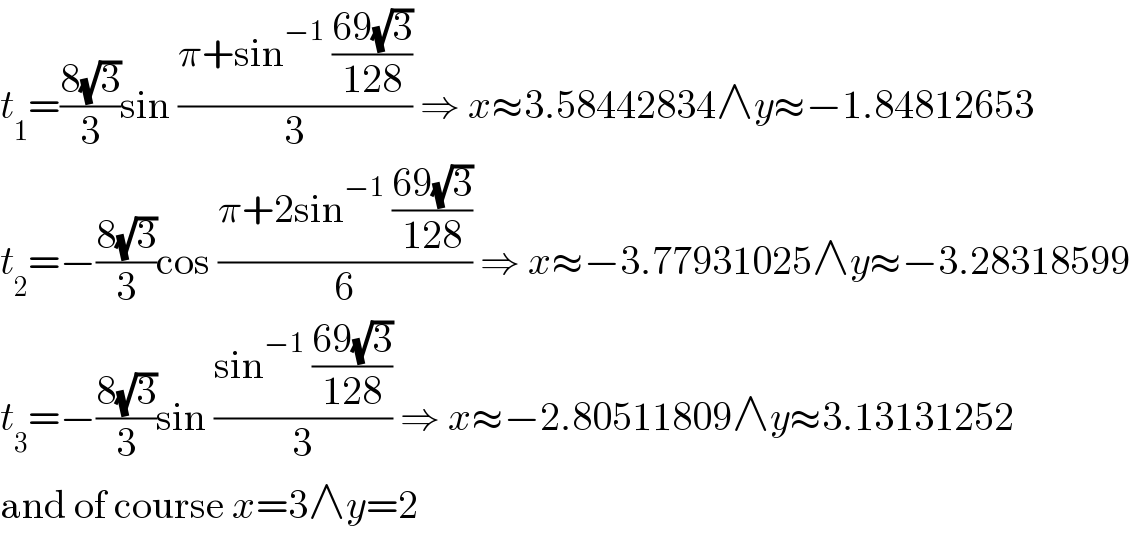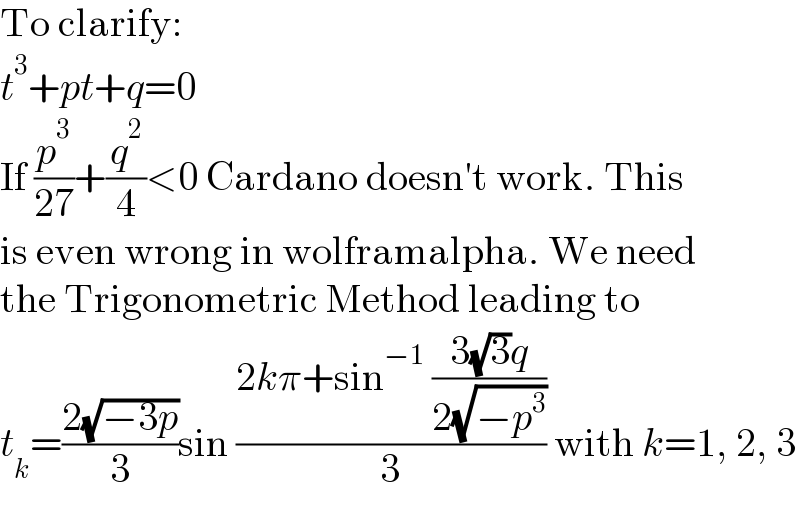
Previous in Differential Equation Next in Differential Equation
Question Number 195301 by deleteduser4 last updated on 29/Jul/23

$$\begin{cases}{{x}^{\mathrm{2}} +{y}=\mathrm{11}}\\{{x}+{y}^{\mathrm{2}} =\mathrm{7}}\end{cases}\Rightarrow\:{x},{y}=? \\ $$
Answered by Frix last updated on 29/Jul/23

$${y}=\mathrm{11}−{x}^{\mathrm{2}} \\ $$$${x}^{\mathrm{4}} −\mathrm{22}{x}^{\mathrm{2}} +{x}+\mathrm{114}=\mathrm{0} \\ $$$$\left({x}−\mathrm{3}\right)\left({x}^{\mathrm{3}} +\mathrm{3}{x}^{\mathrm{2}} −\mathrm{13}{x}−\mathrm{38}\right)=\mathrm{0} \\ $$$${x}_{\mathrm{1}} =\mathrm{3} \\ $$$${x}^{\mathrm{3}} +\mathrm{3}{x}^{\mathrm{2}} −\mathrm{13}{x}−\mathrm{38}=\mathrm{0} \\ $$$${x}={t}−\mathrm{1} \\ $$$${t}^{\mathrm{3}} −\mathrm{16}{t}−\mathrm{23}=\mathrm{0} \\ $$$$\mathrm{3}\:\mathrm{real}\:\mathrm{solutions}\:\Rightarrow\:\mathrm{use}\:\mathrm{trigonometric}\:\mathrm{method} \\ $$$$\mathrm{to}\:\mathrm{get}\:\mathrm{exact}\:\mathrm{values} \\ $$
Commented by deleteduser4 last updated on 29/Jul/23

$${thank}\:{you}\:{sir};\:+\mathrm{38}\:{or}\:−\mathrm{38}? \\ $$
Commented by Frix last updated on 29/Jul/23

$$\mathrm{Typo},\:−\mathrm{38}\:\mathrm{is}\:\mathrm{correct} \\ $$
Commented by Frix last updated on 29/Jul/23

$${t}_{\mathrm{1}} =\frac{\mathrm{8}\sqrt{\mathrm{3}}}{\mathrm{3}}\mathrm{sin}\:\frac{\pi+\mathrm{sin}^{−\mathrm{1}} \:\frac{\mathrm{69}\sqrt{\mathrm{3}}}{\mathrm{128}}}{\mathrm{3}}\:\Rightarrow\:{x}\approx\mathrm{3}.\mathrm{58442834}\wedge{y}\approx−\mathrm{1}.\mathrm{84812653} \\ $$$${t}_{\mathrm{2}} =−\frac{\mathrm{8}\sqrt{\mathrm{3}}}{\mathrm{3}}\mathrm{cos}\:\frac{\pi+\mathrm{2sin}^{−\mathrm{1}} \:\frac{\mathrm{69}\sqrt{\mathrm{3}}}{\mathrm{128}}}{\mathrm{6}}\:\Rightarrow\:{x}\approx−\mathrm{3}.\mathrm{77931025}\wedge{y}\approx−\mathrm{3}.\mathrm{28318599} \\ $$$${t}_{\mathrm{3}} =−\frac{\mathrm{8}\sqrt{\mathrm{3}}}{\mathrm{3}}\mathrm{sin}\:\frac{\mathrm{sin}^{−\mathrm{1}} \:\frac{\mathrm{69}\sqrt{\mathrm{3}}}{\mathrm{128}}}{\mathrm{3}}\:\Rightarrow\:{x}\approx−\mathrm{2}.\mathrm{80511809}\wedge{y}\approx\mathrm{3}.\mathrm{13131252} \\ $$$$\mathrm{and}\:\mathrm{of}\:\mathrm{course}\:{x}=\mathrm{3}\wedge{y}=\mathrm{2} \\ $$
Commented by deleteduser4 last updated on 29/Jul/23

$${very}\:{very}\:{nice}\:{sir};\:{and}\:{infinity}\:{thank}\:{you} \\ $$
Commented by Frix last updated on 30/Jul/23

$$\mathrm{To}\:\mathrm{clarify}: \\ $$$${t}^{\mathrm{3}} +{pt}+{q}=\mathrm{0} \\ $$$$\mathrm{If}\:\frac{{p}^{\mathrm{3}} }{\mathrm{27}}+\frac{{q}^{\mathrm{2}} }{\mathrm{4}}<\mathrm{0}\:\mathrm{Cardano}\:\mathrm{doesn}'\mathrm{t}\:\mathrm{work}.\:\mathrm{This} \\ $$$$\mathrm{is}\:\mathrm{even}\:\mathrm{wrong}\:\mathrm{in}\:\mathrm{wolframalpha}.\:\mathrm{We}\:\mathrm{need} \\ $$$$\mathrm{the}\:\mathrm{Trigonometric}\:\mathrm{Method}\:\mathrm{leading}\:\mathrm{to} \\ $$$${t}_{{k}} =\frac{\mathrm{2}\sqrt{−\mathrm{3}{p}}}{\mathrm{3}}\mathrm{sin}\:\frac{\mathrm{2}{k}\pi+\mathrm{sin}^{−\mathrm{1}} \:\frac{\mathrm{3}\sqrt{\mathrm{3}}{q}}{\mathrm{2}\sqrt{−{p}^{\mathrm{3}} }}}{\mathrm{3}}\:\mathrm{with}\:{k}=\mathrm{1},\:\mathrm{2},\:\mathrm{3} \\ $$
Commented by Frix last updated on 30/Jul/23

$$\mathrm{My}\:\mathrm{solution}\:\mathrm{proves}\:\mathrm{there}\:\mathrm{are}\:\mathrm{4}\:\mathrm{real}\:\mathrm{intersections}. \\ $$$$\mathrm{It}'\mathrm{s}\:\mathrm{obviously}\:\mathrm{a}\:\mathrm{problem}\:\mathrm{of}\:\mathrm{the}\:\mathrm{approximation}. \\ $$$$\mathrm{An}\:\mathrm{imaginary}\:\mathrm{part}\:\mathrm{of}\:\approx.\mathrm{0000000000000001i} \\ $$$$\mathrm{is}\:\mathrm{strange}.\:\mathrm{But}\:\mathrm{as}\:\mathrm{I}\:\mathrm{wrote}\:\mathrm{before},\:\mathrm{your} \\ $$$$\mathrm{picture}\:\mathrm{also}\:\mathrm{shows}\:\mathrm{4}\:\mathrm{real}\:\mathrm{solutions}.\:\mathrm{Do}\:\mathrm{you} \\ $$$$\mathrm{trust}\:\mathrm{more}\:\mathrm{in}\:\mathrm{an}\:\mathrm{algorithm}? \\ $$
